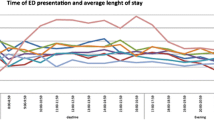Abstract
Length of stay (LOS) is an important determinant of patient satisfaction and overall emergency department (ED) operational efficiency. In an effort to reduce length of stay for low-acuity “treated and released” patients, our department created a discharge facilitator team (DFT) composed of an attending physician, physician assistant, and registered nurse. The DFT identified patients who could be rapidly treated and released in the low-acuity treatment Adult Urgent Care Center (AUCC) and provided them rapid treatment and discharge. To assess the efficacy of the DFT, linear regression was used to compare AUCC LOS at times the team was and was not active. Patients seen by the DFT had a LOS that was 35 % shorter than other AUCC patients. There was a 28-min reduction in AUCC LOS during periods where the DFT was active (95% CI 22 to 33 min). We conclude that the establishment of a DFT was associated with a significant reduction in LOS for all low-acuity patients. Other academic medical centers may consider implementing a similar program in order to reduce LOS and improve ED throughput for low acuity patients.

Similar content being viewed by others

References
Nawar EW, Niska RW, Xu J. National Hospital Ambulatory Medical Care Survey: 2005 Emergency Department Summary. 2007; Advance Data From Vital and Health Statistics, CDC. www.cdc.gov/nchs/data/ad/ad386.pdf. Accessed December 17, 2010.
Niska R, Bhuiya F, Xu J. National Hospital Ambulatory Medical Care Survey: 2007 Emergency Department Summary. National Health Statistics Reports, National Center for Health Statistics. 2010; 23.
American College of Emergency Physicians, Clinical and practice management. The ethics of health care reform: issues in emergency medicine—an information paper. www.acep.org. Accessed December 8, 2011.
Prentice T. Improving front-end ED flow: successful change management. Lecture at ACEP National Meeting. Las Vegas, NV; September 28, 2010.
Derlet RW, Richards JR. Overcrowding in the nation's emergency departments: complex causes and disturbing effects. Ann Emerg Med. 2000; 35: 63–68.
Horwitz LI, Green J, Bradley EH. US emergency department performance on wait time and length of visit. Ann Emerg Med. 2010; 55: 133–41.
Wiler JL, Gentle C, Halfpenny JM, Heins A, Mehrotra A, Mikhail MG, Fite D. Optimizing emergency department front-end operations. Ann Emerg Med. 2010; 55: 142–160.
Green LV, Soares J, Giglio JF, Green RA. Using queuing theory to increase the effectiveness of emergency department provider staffing. Acad Emerg Med. 2006; 13: 61–68.
Maister D. The Psychology of Waiting Lines. In: Czepiel JA, Solomon MR, Surprenant CF, eds. The service encounter: managing employee/customer interaction in service businesses. Lexington: D. C. Heath and Company, Lexington Books; 1985.
Author information
Authors and Affiliations
Corresponding author
Rights and permissions
About this article
Cite this article
Sharma, R., Mulcare, M.R., Graetz, R. et al. Improving Front-End Flow in an Urban Academic Medical Center Emergency Department: The Emergency Department Discharge Facilitator Team. J Urban Health 90, 406–411 (2013). https://doi.org/10.1007/s11524-012-9752-0
Published:
Issue Date:
DOI: https://doi.org/10.1007/s11524-012-9752-0



